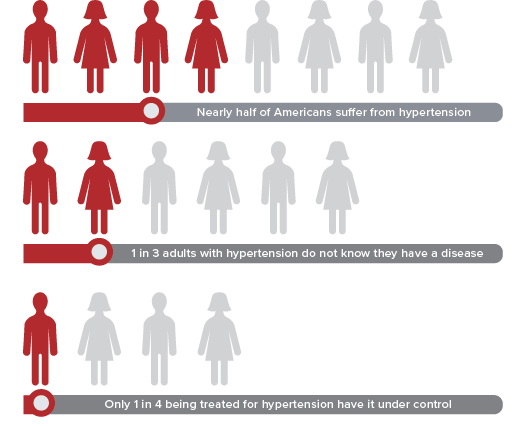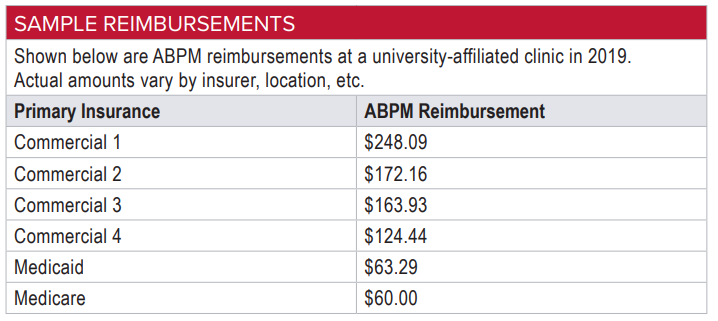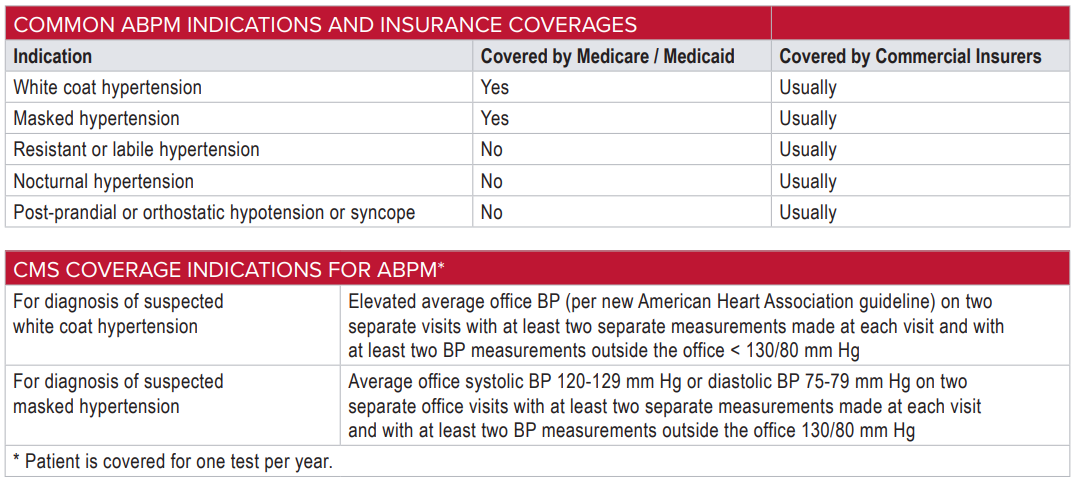Evidence from the front lines supporting use of ambulatory blood pressure monitoring (ABPM) and what you need to know.
While patients can check their blood pressure at home or at the drug store, clinicians still rely mostly on in-office blood pressure readings for hypertension management. But readings can be inaccurate for a variety of reasons, including white coat hypertension and masked hypertension. At-home monitoring is superior to office readings in predicting future cardiovascular events, morbidity, mortality, and target organ damage, and there is increasing evidence supports the 24-hour ambulatory blood pressure monitoring (ABPM) approach. Evidence has been accumulating over the past decade demonstrating results of ABPM as superior to office blood pressure in predicting cardiovascular outcomes.
Evidence from the front lines supports use of ambulatory ABPM. Learn about setting up an ABPM program in your practice.
What is Ambulatory Blood Pressure Monitoring?
Ambulatory blood pressure monitoring measures blood pressure at regular intervals over a 24-hour period while a patient continues with activities of daily living. A specialized monitoring device is programmed to take blood pressures at pre-determined intervals, during both sleep and awake cycles, resulting in a comprehensive picture of a patient’s blood pressure rather than a few measurements taken while the patient is sitting in a healthcare provider’s office.
Nearly half of American adults (47% or 116 million) have hypertension(1) making it the most common condition seen in care(2) and why it is likely first identified in this setting. Roughly 1 in 3 US adults with hypertension are unaware they have the disease, and of those being treated, only 1 in 4 adults have it under control.(1)
The effects of hypertension
Hypertension can damage artery and blood vessel walls over time and affect many organs within the body such as the heart, brain, kidney and eyes.(3) Despite several treatment options being available, adequate control is still low in many people with hypertension.(1) This greatly increases the risk for heart disease and stroke, the first and third leading causes of death in the US.(4)
Why is blood pressure monitoring sometimes not enough?
While patients can check their blood pressure at home or at the drug store, clinicians still rely mostly on in-office blood pressure readings for hypertension management. But readings can be inaccurate for a variety of reasons, including white coat hypertension and masked hypertension.(5)
At home monitoring is superior to office readings in predicting future cardiovascular events, morbidity, mortality, and target organ damage, and there is increasing evidence supports the 24-hour ambulatory blood pressure monitoring (ABPM) approach.(5) Evidence has been accumulating over the past decade demonstrating results of ABPM as superior to office blood pressure in predicting cardiovascular outcomes.(6)

When is APBM indicated?
There are several clinical indications for ABPM including to rule out white coat hypertension, which affects approximately 20% of adults.(7) This can enable a healthcare provider to determine whether a patient’s in-office blood pressure elevations reflect an anxious state instead of a quiet resting state that is required for an accurate blood pressure recording.(7) These patients have similar cardiovascular risk to patients with normal blood pressures and typically do not need medications.
ABPM can also detect the reverse condition, masked hypertension, where the patient has a normal blood pressure during the examination but uncontrolled blood pressure at home.(8) Out-of-office measurements are highly recommended as an adjunct to office measurements by almost all hypertension organizations.(9) ABPM also has been shown to provide greater prognostic ability in estimating cardiovascular risk.(10)
A study published in the British Medical Journal concluded that neither clinic nor home measurement had sufficient sensitivity or specificity to be recommended as a single diagnostic test,(10) and that ambulatory monitoring before the start of lifelong drug treatment might lead to more appropriate targeting of treatment, particularly around the diagnostic threshold.(10)
In an article published in the American Heart Association Hypertension, ABPM is currently considered the gold standard for the correct diagnosis of hypertension.(11) Ambulatory blood pressure provides extensive information on several BPM parameters other than the average blood pressure, including blood pressure variability, morning blood pressure surge, blood pressure load, and nocturnal fall in blood pressure. Monitoring blood pressures during sleep can only be accomplished with ABPM. And asleep systolic blood pressure is the most significant blood pressure derived risk factor for cardiovascular events.(19) Some consider ABPM to complimentary to home blood pressures rather than competitive.(12)
Economic considerations
Despite the clinical advantages of ABPM, clinicians may face economic challenges incorporating it into their practices. (12) ABPM devices cost about $2,000 to $2,500 each, not including the cost of software as well as training time for staff on how to use the software. A practice with a significant number of commercially insured patients could generate a net of about $100 per test, which translates to a practice exceeding the upfront investment cost after approximately 50 tests.(5) For practices with a significant number of Medicare and Medicaid patients, it could be more challenging to justify the investment.

Spacelabs Healthcare’s ABPM solutions
Here are some key things to consider as reported by the American Association of Family Practice if considering setting up an ABPM program(5) and how Spacelabs Healthcare ABPM Solutions can help you get you there.
Step 1: Determine practice goals
- Is this to serve an unmet demand, or will one goal be to raise awareness first about ABPM and its role in hypertension diagnosis?
Step 2: Determine eligibility criteria for ABPM
- Depending on its goals, each practice can establish different criteria to decide which patients may benefit from ABPM.


Step 3: Create an ABPM team
- Clinical staff do not need special certification. Nurses and medical assistants can be trained to fit a patient for an arm cuff and prepare the monitoring device.
- Front desk and administrators should be consulted early to ensure smooth billing and compliance.
- Spacelabs Healthcare provides pre-install and go-live support, our team will partner with you to define the most efficient workflows. We pride ourselves on our technical and clinical support well beyond installation.
Step 4: Select an ABPM device and software
- Select a vendor with a long track record of success.
- Spacelabs ambulatory blood pressure devices are built on more than 40 years of ABPM technology innovation.
- Spacelabs ABPM has been used in over 500 clinical studies including the landmark DASH(13), SYST-EUR(14) and AASK analyses.(15)
- Select ABPM devices that have undergone independent validation testing.
- Spacelabs ABPM devices have been tested and validated against the top three recognized international protocols. AAMI/ANSI/ISO 81060* (adults and children)(16) , British Hypertension Society (17) and the European Hypertension Society(18).
- Ensure the ability to network your ABPM reporting to facilitate data sharing and EMR integration.
- Spacelabs Sentinel Cardiology Information Management System fully integrates your devices and data
into powerful yet simple to use web-based software package.
- Spacelabs Sentinel Cardiology Information Management System fully integrates your devices and data
- Look for features that increase patient compliance.
- Spacelabs ABPM devices are compact in design, light weight and quiet. OnTrak includes comfort settings and child mode that control initial inflation pressure, reducing patient anxiety and enhancing compliance.
- The device should provide activity graphs that can help clinicians understand sleep/wake cycles.
- Spacelabs’ OnTrak includes an accelerometer than can help clinicians understand sleep/wake cycles based on patient activity.
Step 5: Create an ABPM protocol
- Determine how clinicians will order and schedule patients.
- Spacelabs clinical support team can help ensure a seamless fit into your clinician workflow.
- Create a pre-monitoring checklist that includes device availability and initialization.
- Create instructions for applying the device to patients and for the retrieval/return of device.
Step 6: Prepare and interpret results (include network sharing)
- Create a procedure for importing stored device data, ensuring an adequate number of readings is included (no universally agreed upon amount, but current convention is at least 20 awake readings), and saving it securely.
- Spacelabs Clinical Education Specialists can help determine the best configuration for your patient population.
- Interpret report and determine diagnosis.
Outpatient providers are more likely to be the first to recognize and manage hypertension. Ambulatory blood pressure monitoring has proven benefits for patient care and — with the right payer mix and the right personnel — can be a financially sustainable addition to a practice. From strategic planning through post-installation support and continuous improvement, count on Spacelabs TeamUp strategies experts to help you achieve your clinical and business ambitions when implementing an ABPM program in your practice.
Trusted and proven: Ambulatory Blood Pressure Monitoring
As healthcare organizations increasingly seek technology that facilitates evidence-based, data-driven decisions, healthcare executives are turning to Spacelabs Arrhythmia Diagnostics and Ambulatory Blood Pressure Monitoring to support efforts to improve the delivery of patient care, increase caregiver satisfaction and reduce costs. Our ABPM solutions, combined with the Sentinel cardiology information management system, provide a secure and scalable solution for all your hypertension needs regardless of clinic location.
If you are interested in learning more about Spacelabs Healthcare and its ABPM products and services, please contact us. We can arrange an on-site discussion or video conference at your convenience.
References
(1) Facts About Hypertension | cdc.gov
(2) 10 Most Common Diagnoses and Procedures in Primary Care (definitivehc.com)
(3) Usefulness of ambulatory blood pressure monitoring (ABPM) in daily clinical practice: Data from the Spanish ABPM registry – Segura – 2014 – Clinical and Experimental Pharmacology and Physiology – Wiley Online Library
(4) High Blood Pressure Symptoms and Causes | cdc.gov
(5) Implementing Ambulatory Blood Pressure Monitoring in Primary Care Practice (aafp.org)
(6) Relative effectiveness of clinic and home blood pressure monitoring compared with ambulatory blood pressure monitoring in diagnosis of hypertension: systematic review – PubMed (nih.gov)
(7) White-Coat Hypertension and Masked Hypertension | Cedars-Sinai
(8) Prevalence of Masked Hypertension Among US Adults With Nonelevated Clinic Blood Pressure – PubMed (nih.gov)
(9) Which out-of-office measurement technique should be used for diagnosing hypertension in prehypertensives? – PubMed (nih.gov)
(10) Relative effectiveness of clinic and home blood pressure monitoring compared with ambulatory blood pressure monitoring in diagnosis of hypertension: systematic review – PubMed (nih.gov)
(11) Ambulatory and Home Blood Pressure Measurement | Hypertension (ahajournals.org)
(12) Barriers to conducting ambulatory and home blood pressure monitoring during hypertension screening in the United States – PubMed (nih.gov)
(13) Dietary Approaches to Stop Hypertension (DASH): potential mechanisms of action against risk factors of the metabolic syndrome – PubMed (nih.gov)
(14) Systolic Hypertension in Europe (Syst-Eur) trial phase 2: objectives, protocol, and initial progress. Systolic Hypertension in Europe Investigators – PubMed (nih.gov)
(15) The African American Study of Kidney Disease and Hypertension (AASK) trial: what more have we learned? – PubMed (nih.gov)
(16) AAMI: Assoc. for the Advancement of Medical Instrumentation (ansi.org)
(17) Homepage – British and Irish Hypertension Society | Registered UK Charity No. 287635 (bihsoc.org)
(18) European Society of Hypertension (eshonline.org)
(19) Asleep blood pressure: significant prognostic marker of vascular risk and therapeutic target for prevention – PubMed (nih.gov)
